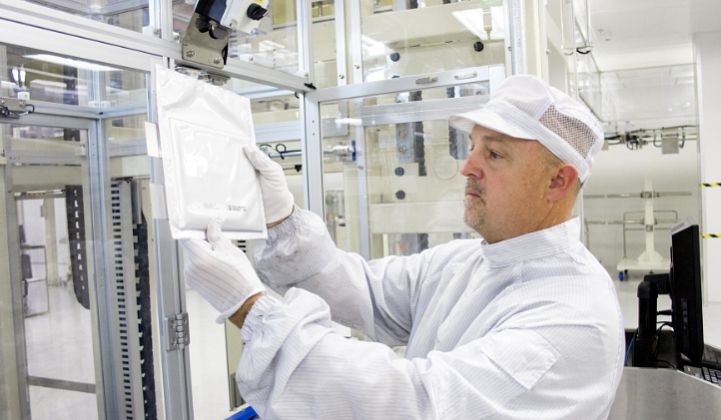LG Chem is ending the year on a high note after securing two of the world’s largest energy storage projects and leading an electric-vehicle battery manufacturer survey.
In late November, LG Chem won contracts to install a 50-megawatt-hour storage facility in South Korea and a 140-megawatt-hour project in Germany. That same week, the firm was named the world’s top electric-vehicle battery maker in terms of strategy and execution by Navigant Research.
The Navigant Leaderboard Report, which looked at companies making lithium-ion batteries for transportation, did not factor in current market share. Panasonic currently leads the market, but the company is under threat from LG Chem, according to an August report from Lux Research.
Navigant examined the business strategies of eight leading lithium-ion battery manufacturers active in the light-duty electric-vehicle market. It put LG Chem ahead of Panasonic based on an analysis of twelve criteria, which included vision, go-to-market strategy, partners, technology, geographic reach, and sales, marketing and distribution.
Samsung SDI came third in the ranking, followed by AESC, Johnson Controls, BYD and A123, which were all listed as "contenders" rather than "leaders."
Last month, Tesla confirmed it was switching from Panasonic -- its usual cell vendor -- to LG Chem products in its Roadster battery pack upgrades. The news was a blow for Panasonic, which has built its electric-vehicle battery business largely on the back of Tesla sales.
LG Chem is also becoming a supplier of choice for leading auto brands such as General Motors, Renault and Daimler.
LG Chem’s grid storage business was also bolstered with two major wins announced at the end of last month.
The 50-megawatt-hour South Korean battery, which will be paired with a wind farm, is being touted as the largest of its kind. The project will be built on behalf of GS E&R, a privately owned South Korean developer. GS E&R has been operating the wind farm since September, and the storage facility will help it smooth out intermittency from the turbines.
The GS E&R project was announced a day after LG Chem unveiled a deal to supply 90 megawatts and 140 megawatt-hours of storage to STEAG, a German utility.
The battery storage will be spread across six power plants, in Herne, Lünen, Duisburg-Walsum, Bexbach, Fenne and Weiher, between mid-2016 and the beginning of 2017. The batteries will be used for frequency regulation.
The STEAG win follows other recent grid-scale deployments, such as a 2-megawatt system for Duke Energy and a 1-megawatt project for OCI Solar Power in the U.S.
LG Chem claims to have won 100 megawatt-hours' worth of orders for residential energy storage in 2015 and is also eyeing opportunities in the commercial and industrial sectors.
Philip Hiersemenzel, a spokesperson for Younicos, which developed the OCI Solar Power project, said he expected the battery maker to announce further projects in South Korea following the GS E&R win.
“[South] Korea is their home market, and it’s effectively an island,” he said. “They are also open to new technologies, have great renewable energy potential and are driven by their car industry. I think we’ll see a lot more happening there in future.”



